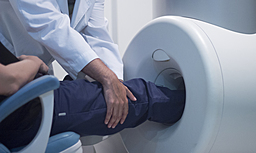An Orientation-Independent Order Parameter Derived from Magnetic Resonance R1rho Dispersion in Ordered Tissue
TECHNOLOGY NUMBER: 2019-280

OVERVIEW
Removing magic angle effect from R1rho Dispersion MRI for orientation independent imaging- Maintains intrinsic sensitivity to the structural integrity of collagen fibers
- Reveals cartilage alterations in highly structured tissues
BACKGROUND
A hallmark of joint osteoarthritis (OA) is a progressive loss of cartilage that can cause painful joints or even mobility impairments if the loss becomes severe. MRI has the potential to detect early OA and thus will help scientists to develop an interventional strategy to protect or regenerate cartilage. However, conventional compositional MRI suffers from a well-known "magic angle effect (MAE)" in highly structured tissues such as cartilage tendon and potentially fibrous connective tissues in liver and myocardium, making an early diagnosis on cartilage degeneration in clinical practice extremely challenging.
INNOVATION
The current technology provides a solution to remove the spatial signal variations resulting from the MAE while maintaining an intrinsic sensitivity to the structural integrity of collagen fibers. This approach allows compositional MRI to be used for characterizing the focalized cartilage degeneration on the same knee in clinical studies. Without separation of MAE from MRI relaxation measurements, the compositional MRI will be only useful for longitudinal studies. Preliminary data on different cartilage tissues, from healthy human knee in vivo to OA human knee ex vivo to enzymatically depleted bovine patellae ex vivo, have demonstrated that a derived order parameter was not only sensitive to collagen degeneration but also free from MAE. This developed technology will provide a new tool for clinical scientists and physicians to reveal cartilage alterations in highly structured tissues.